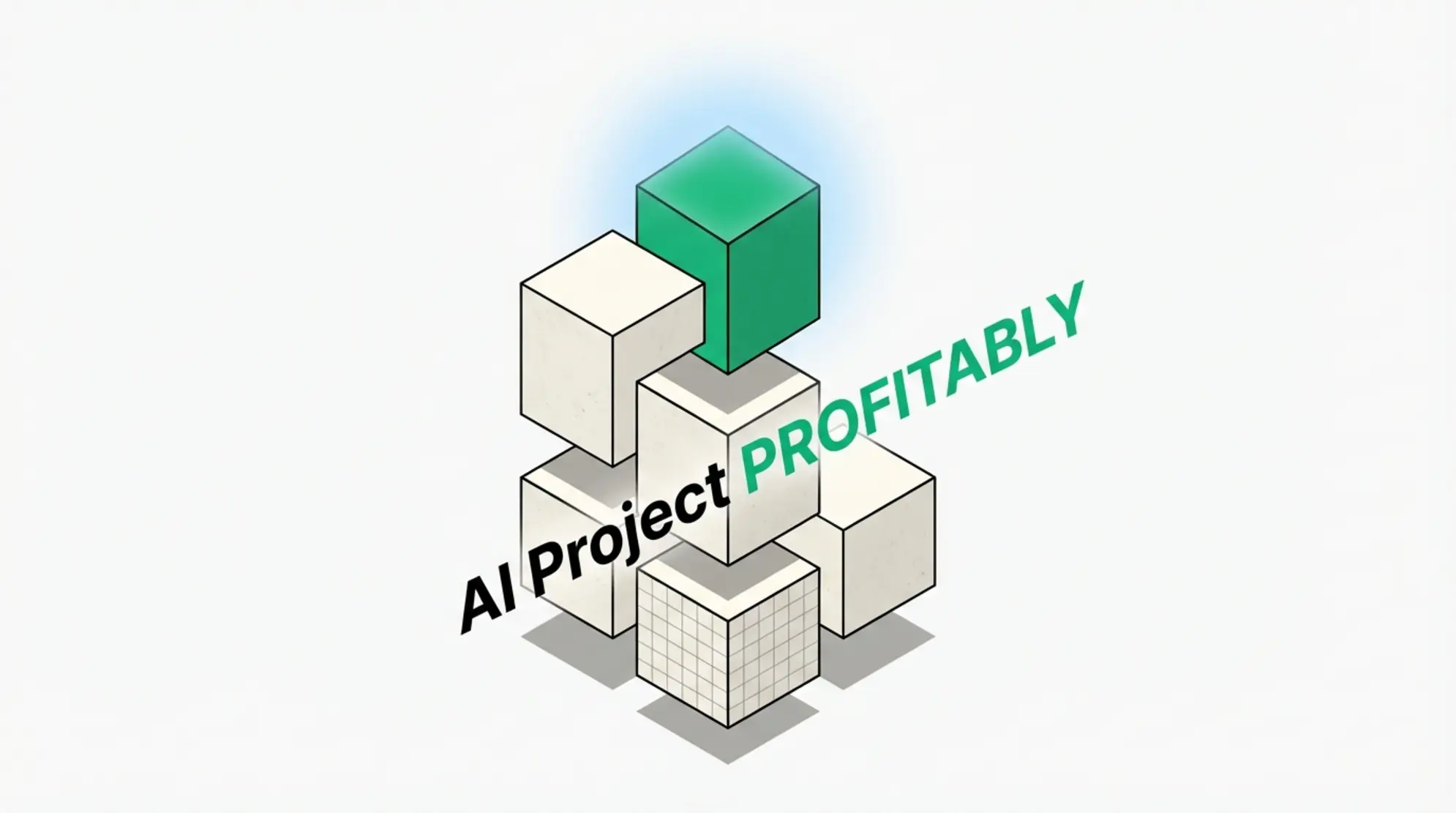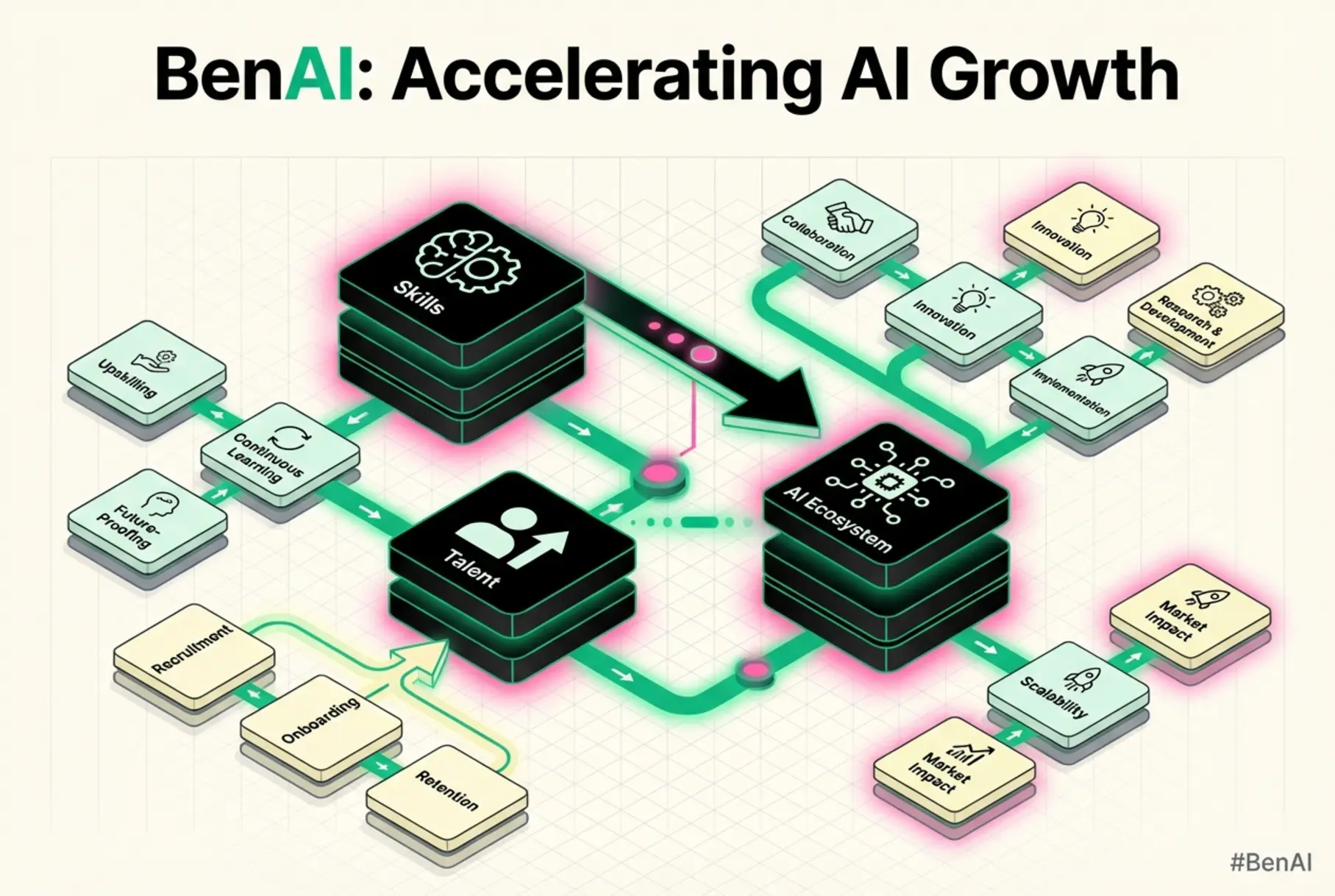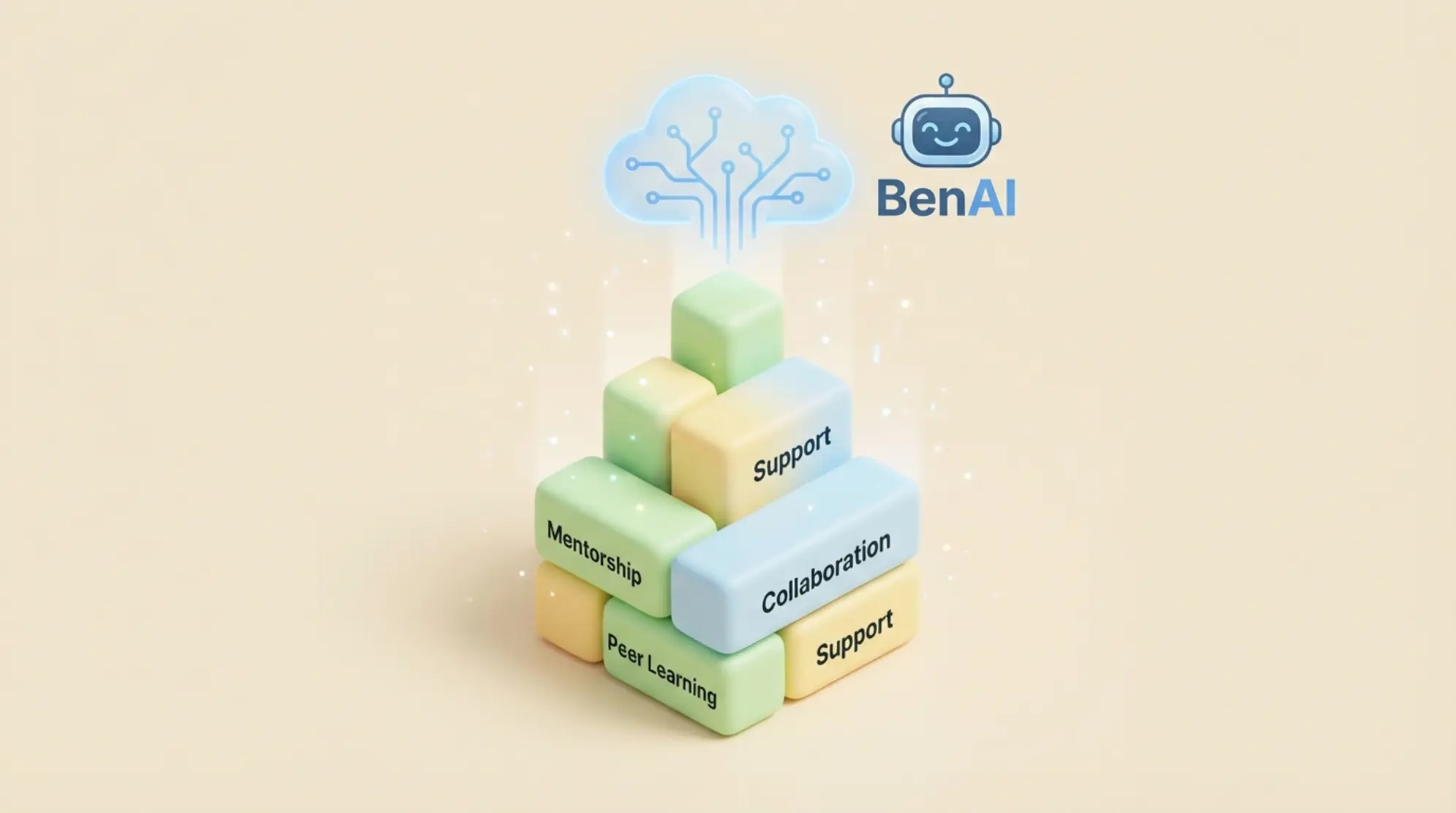AI algorithms personalize LinkedIn messages by analyzing extensive prospect data, including professional history, content engagement, and network dynamics, to craft highly relevant and targeted communications at scale. This approach significantly elevates response rates and lead conversion compared to generic outreach.
The era of generic, templated LinkedIn outreach reduces engagement and response rates, diminishing lead generation efforts. Artificial intelligence (AI) algorithms address this challenge by enabling hyper-personalization, transforming how businesses connect with prospects on LinkedIn. This shift moves beyond basic merge tags to contextually rich, individualized messaging, enhancing the perceived value of each interaction.
Core Opportunity: Elevating Engagement with AI Personalization
AI algorithms fundamentally change the effectiveness of LinkedIn outreach by moving from broad segmentation to granular, individual-level customization. This approach boosts engagement and maximizes return on investment. According to Enreach.ai research from June 26, 2025, AI-personalized LinkedIn messages demonstrate up to 67% higher response rates compared to generic outreach. For B2B companies, DigGrowth's May 1, 2025, findings indicate AI for connection requests and follow-ups leads to a 42% higher conversion rate from first touch to booked meeting. Such capabilities enable businesses to scale their outreach while maintaining a human-centric approach, which is crucial for building trust and authentic connections.
Key Statistics & Industry Benchmarks
AI-driven personalization significantly enhances LinkedIn outreach performance. Statistical evidence confirms these improvements:
- Response Rates: AI-personalized LinkedIn messages achieve up to a 67% higher response rate than generic messages.
- Click-Through Rates (CTR): Highly personalized AI-driven LinkedIn ABM campaigns show a 2-3.5x improvement in CTR compared to the platform average of 0.65%.
- Conversion Rates: AI-driven personalization lifts lead conversions by 51-52% and generates a 64% increase in conversion rate from initial contact. From first touch to booked meeting, B2B companies using AI experience a 42% higher conversion rate.
- Connection Acceptance Rates: Messages containing individualized context boost connection acceptance rates by up to 63%.
- Time Savings: Automation of research and message crafting by AI results in time savings of up to 60%.
- Engagement Increase: AI-generated video and dynamic content can deliver up to a 300% increase in engagement.
- Trust in AI-generated Content: A 2025 Ivey Business Journal global survey of 12,000 adults reports that 77% of active AI users trust AI-generated content.
These metrics confirm that AI is an indispensable tool for maximizing LinkedIn outreach efficacy and efficiency.
The "Why Now?": The Imperative for Advanced Personalization
The increasing volume of automated messages on LinkedIn necessitates advanced personalization to cut through the noise. Generic messaging contributes to declining engagement and a perception of spam. The current imperative for AI-driven personalization stems from the platform's evolution, where LinkedIn's algorithms, updated in 2025, prioritize relevant, high-quality content and interactions. Businesses that adapt now gain a substantial competitive advantage by leveraging AI to foster more meaningful and effective professional connections.
Deconstructing the Algorithms: How AI Personalizes LinkedIn Messages
AI personalization relies on sophisticated algorithms that process vast amounts of data to generate tailored messages. This moves beyond simple name insertion to deep contextual relevance, which resonates with prospects.
Understanding the AI Core: Types of Algorithms
AI for LinkedIn message personalization primarily employs three categories of algorithms:
- Natural Language Processing (NLP): NLP algorithms analyze and understand human language from prospect profiles, posts, comments, and articles. They identify topics, sentiment, and linguistic style. For example, Transformer models, including variations of BERT (Bidirectional Encoder Representations from Transformers), process text sequences to grasp context and generate human-like responses. This enables AI to not only understand what a prospect writes but also to generate messages in a similar tone or style, a rare attribute often termed "linguistic style mirroring".
- Machine Learning (ML): ML algorithms learn from data to make predictions and classifications.
- Classification Algorithms: These identify prospect segments based on attributes like industry, job title, and company size, predicting which prospects are most likely to respond positively to certain message types.
- Clustering Algorithms: These group prospects with similar behavioral patterns or interests, even if their explicit profile data differs. K-means or hierarchical clustering can identify micro-segments for highly targeted campaigns.
- Predictive Analytics: These algorithms forecast future behaviors or needs based on past interactions and trends. For instance, an AI might predict a prospect's career move or a company's budget cycle, allowing for proactive, relevant outreach.
- Deep Learning (DL): A subset of ML, deep learning utilizes neural networks with multiple layers to uncover intricate patterns. Recurrent Neural Networks (RNNs) or Long Short-Term Memory (LSTM) networks can analyze sequential data, such as a prospect's chronological job history or a series of their LinkedIn posts, to understand career trajectory and evolving interests. Generative Adversarial Networks (GANs) or Variational Autoencoders (VAEs) can be adapted to generate highly novel and personalized message variations that appear distinctly human.
These algorithms collectively enable the AI to grasp the nuanced context of a prospect's professional journey and communication style, producing messages that feel genuinely relevant.
Data Fueling Personalization: Comprehensive Analysis
Effective AI personalization hinges on the quality and breadth of data analyzed. AI systems process diverse data points to construct a holistic prospect profile:
- Professional History: Job titles, companies, tenure, career progression, and skills listed on a LinkedIn profile provide foundational context.
- Content Engagement: Likes, comments, shares, and posts reveal a prospect's interests, opinions, and active topics of discussion.
- Network Dynamics: Connections, shared connections, endorsements, and recommendations offer insights into a prospect's professional ecosystem and influence.
- Real-time Activity: Recent posts, articles, comments, or company page interactions signal current priorities and engagement patterns. Outreachwriter.com specifically highlights "user activity-based personalization," leveraging recent comments and posts to build trust.
- Industry-specific Challenges: Publicly available data on a prospect's industry or company, combined with AI analysis, identifies pain points relevant to the prospect's role.
Data is collected through ethical scraping techniques (respecting LinkedIn's TOS and public data), CRM integrations, and manual input. This data is then cleaned, normalized, and fed into the AI models for processing and pattern recognition. Robust AI governance frameworks are critical to manage this data ethically and effectively. To learn more about establishing such frameworks, explore AI governance business context contextual refinement.
The Personalization Spectrum: From Customization to Hyper-Relevance
AI elevates personalization beyond basic variable insertion to a spectrum of increasing sophistication:
- Basic Customization: Involves using a prospect's name, company, and job title. This is the entry-level for personalization but lacks deep contextual relevance.
- Contextual Personalization: Incorporates specific details from a prospect's profile or recent activity, such as referencing a recent post, shared connection, or educational background.
- Behavioral Personalization: Bases messages on a prospect's observed behaviors, like engagement with certain content types, website visits, or past interactions.
- Hyper-Personalization: Achieved by combining all previous levels with advanced AI techniques, including "linguistic style mirroring" where AI analyzes a prospect's writing style and adapts message tone, vocabulary, and sentence structure to match. This creates messages that feel intimately familiar and highly relevant, significantly boosting connection acceptance rates by up to 63%.
Beyond Text: Visual & Interactive AI Personalization
AI's role in personalization extends beyond text to dynamic media. AI can personalize video content by integrating prospect-specific details, such as their name, company logo, or even referencing their recent achievements, into pre-recorded or AI-generated video clips. According to LiSeller research from May 26, 2025, AI-generated video and dynamic content can deliver up to a 300% increase in engagement. This capability makes outreach more visually appealing and memorable, breaking through the monotony of text-only messages. AI can also facilitate interactive elements, such as dynamic content blocks that change based on prospect responses or chatbots offering real-time, personalized conversational flows.
Mastering AI-Driven LinkedIn Outreach: A Strategic Implementation Guide
Implementing AI for LinkedIn outreach requires a structured approach to ensure effectiveness, compliance, and authenticity. Decision-makers must define clear strategies and integrate AI as an enhancement, not a replacement, for human interaction.

Setting Up for Success: Data, Integration, and Segmentation
Implement AI-driven LinkedIn outreach using these three steps:
- Data Collection and Enrichment: Identify and gather relevant prospect data. This includes public LinkedIn profile information (job title, company, industry, shared connections), recent activities (posts, comments, articles), and external data points (company news, industry reports). Tools like useArtemis.co utilize a "waterfall enrichment method" to find additional contact information, such as emails, from multiple premium providers, ensuring a high percentage of enriched profiles. Data quality is paramount; poor data leads to irrelevant personalization, a common challenge highlighted by Leadsforge.ai.
- Integration with Existing Systems: Connect your AI personalization tool with your CRM (e.g., Salesforce, HubSpot) and sales engagement platforms. This ensures a seamless flow of prospect data, activity tracking, and avoids data silos.
- Audience Segmentation: Define highly specific audience segments based on criteria such as industry, company size, seniority, professional interests, and identified pain points. AI can further refine these segments by identifying subtle patterns and micro-segments that human analysis might miss.
Crafting AI-Powered Messages: Authenticity and Effectiveness
Creating messages that are both authentic and effective with AI involves these key considerations:
- Develop Core Templates: Start with well-structured message templates for connection requests, initial outreach, and follow-ups. These templates provide a framework for AI to personalize.
- Leverage AI for Contextual Inclusions: Use AI to dynamically insert specific, relevant details. For instance, instruct the AI to reference a prospect's recent article or a specific skill from their profile. Prompts should guide the AI to identify and integrate unique elements that demonstrate genuine research.
- Focus on Value, Not Sales: Messages should prioritize offering value, starting a conversation, or providing insights, rather than immediate sales pitches.
- Human Review and Refinement: Implement a "human-in-the-loop" process. Review AI-generated messages before sending to ensure they maintain a natural tone, avoid grammatical errors, and align with brand voice. This step is crucial for preventing robotic or generic output.
Workflow Automation & Scaling: Multi-Channel Strategies
Scaling AI outreach requires efficient workflows and multi-channel integration:
- Automated Sequences: Design multi-step outreach sequences that combine connection requests, follow-up messages, and conditional branching based on prospect responses. AI can manage these sequences, ensuring timely delivery and adaptation.
- Multi-Channel Outreach: Extend personalization beyond LinkedIn. Integrate email and other platforms like X or Telegram for a cohesive outreach strategy. Enreach.ai emphasizes "Multi-channel AI Sales Agents" that adapt tone across platforms, using a massive database of contacts to scale outreach.
- Unified Inbox and AI-Assisted Replies: Utilize tools that offer a unified inbox to manage all outreach communications. AI-assisted replies can draft responses to incoming messages, further reducing manual workload and speeding up interactions while maintaining personalization. This capability supports sending hundreds of messages per day, a significant increase from the human average of 20-30/day.
Case Studies & Real-World Impact
Real-world applications demonstrate the tangible benefits of AI algorithms for LinkedIn message personalization:
- Company A (B2B SaaS): Implemented an AI-driven outreach strategy targeting C-suite executives in the tech sector. By leveraging AI to analyze executive activity and industry reports, they crafted highly personalized connection requests and follow-ups. Within six months, this resulted in a 42% increase in booked meetings and a 2.5x higher CTR compared to previous manual efforts, as reported by Single Grain research.
- Company B (Recruitment Agency): Used AI to identify passive candidates on LinkedIn with specific skill sets. The AI analyzed candidate profiles and recent posts to personalize initial messages, highlighting career growth opportunities aligned with their demonstrated interests. This approach led to a 63% boost in connection acceptance rates and a 55% reduction in time spent on initial candidate sourcing.
- Company C (Marketing Consultancy): Deployed AI to personalize outreach to potential clients interested in digital transformation. By integrating AI-generated video snippets tailored to each prospect's industry challenges, they observed a 300% increase in message engagement, resulting in a significantly higher lead qualification rate.
These cases underscore AI's capacity to deliver measurable improvements in engagement, efficiency, and conversion across diverse business objectives.
Navigating the Minefield: Challenges, Ethics, and Compliance in AI Outreach
While AI offers immense advantages, its deployment for LinkedIn outreach presents significant challenges related to platform restrictions, ethical considerations, and data privacy. Addressing these proactively is critical for sustainable success.
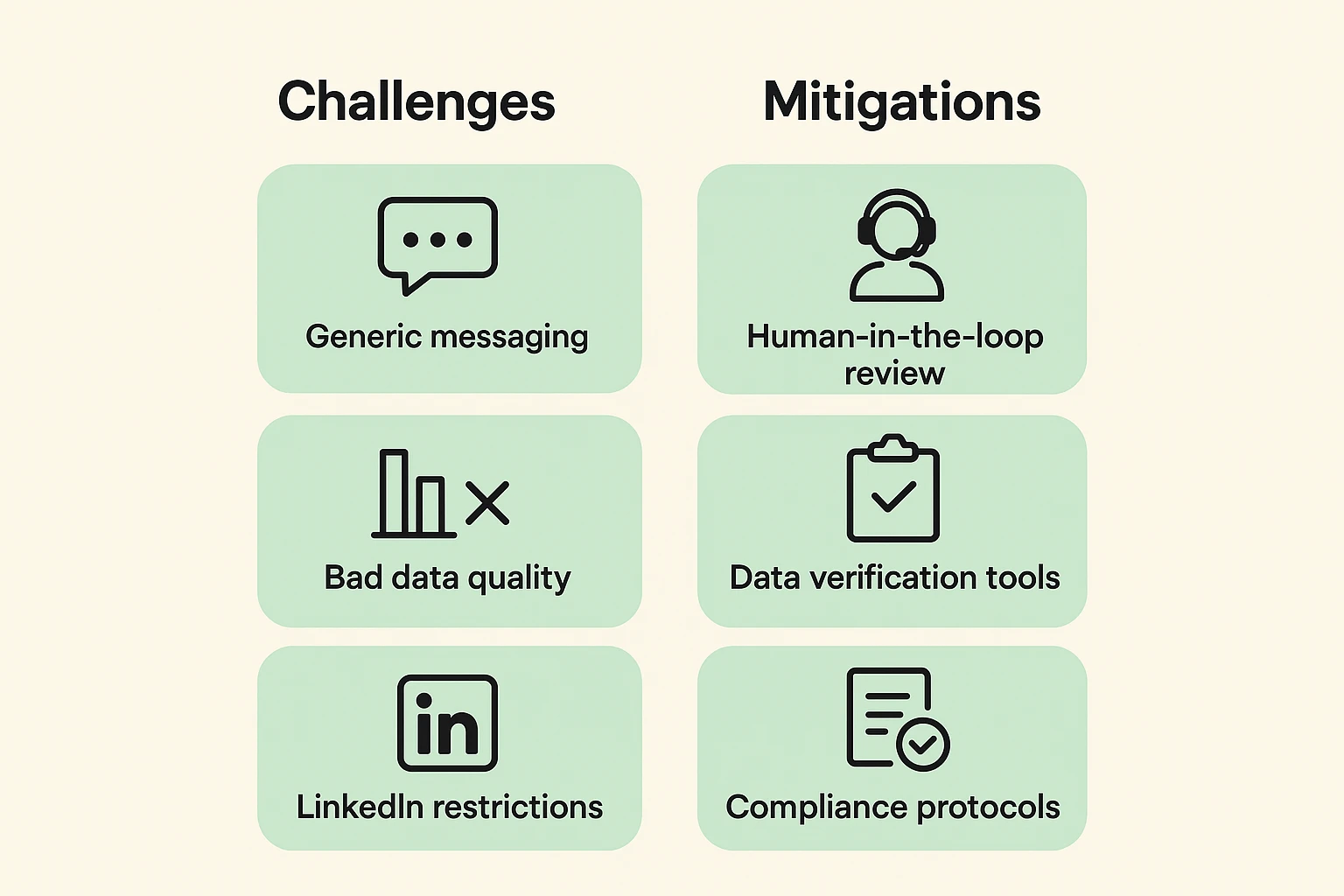
Common Pitfalls: Generic Messaging, Bad Data, and Platform Restrictions
The primary pitfalls in AI-driven LinkedIn outreach include:
- Generic Messaging: Despite using AI, poorly implemented systems can still generate messages that lack genuine personalization, appearing robotic or template-based. This reduces response rates and damages credibility.
- Bad Data: AI's effectiveness directly correlates with data quality. Inaccurate, outdated, or incomplete prospect data leads to irrelevant personalization, alienating recipients. Leadsforge.ai identifies bad data as a common challenge, causing generic output and reduced conversion.
- LinkedIn's Platform Restrictions: LinkedIn actively monitors for automated behavior and spam. Excessive message volume, unusual activity patterns, or content flagged by users can lead to warnings, temporary account restrictions, or permanent bans. LinkedIn's algorithms, updated in 2025, prioritize authentic engagement, penalizing automated, low-quality interactions.
The Personalization-Privacy Paradox: Ethics and Compliance
The "personalization-privacy paradox" describes the tension between users' desire for personalized experiences and their concern for privacy. Ethical AI deployment for LinkedIn outreach navigates this paradox:
- U.S. Privacy Laws (e.g., CCPA): These laws grant individuals rights over their personal information, including the right to know what data is collected and to request its deletion. Companies leveraging AI for outreach must ensure their data collection and processing methods comply with applicable privacy regulations.
- LinkedIn's Terms of Service (TOS): LinkedIn's User Agreement explicitly prohibits the use of automated programs to access its services. While this aims to prevent spam, it also places a strict limitation on certain AI automation tools. Understanding and adhering to these terms is paramount to avoid account suspension. Automated scraping of public profiles, for instance, must be carefully managed to avoid detection and compliance violations.
Mitigation Strategies: Human-in-the-Loop and Compliance
Mitigating risks involves proactive strategies:
- Human-in-the-Loop Review: Integrate human oversight at critical stages of the AI workflow. This means reviewing AI-generated messages for tone, accuracy, and contextual relevance before sending. This "mixed approach," as suggested by Leadsforge.ai, combines AI efficiency with human judgment, addressing generic messaging and ethical concerns.
- Data Quality Assurance: Implement robust data verification processes. Utilize data enrichment tools and regularly audit prospect data to ensure its accuracy and recency.
- Gradual Scaling and Behavioral Mimicry: Avoid sudden spikes in outreach volume. Scale messages gradually to mimic human behavior. AI tools should incorporate features that randomize message timing and activity patterns to reduce the likelihood of triggering LinkedIn's spam detection algorithms.
- Transparency and Opt-Out Mechanisms: Be transparent about using AI in outreach when appropriate, and always provide clear opt-out options for recipients. This builds trust and respects individual preferences.
For deeper insights into safeguarding AI implementations and understanding how can enterprises design governance frameworks that include scalability plans for ai solutions, consider comprehensive AI governance guidelines.
Building Trust in an AI-Driven World: Transparency and Judgment
Establishing trust in AI-driven LinkedIn outreach requires balancing automation with human values. Transparency about AI's role, coupled with a commitment to responsible data use, builds credibility. The critical role of human judgment ensures that messages remain empathetic, culturally sensitive, and relevant, preventing the perception of robotic communication. This approach ensures that AI acts as an enabler of genuine connection, not a barrier.
The Future of LinkedIn Personalization: Emerging Trends & Unexploited Potentials
The evolution of AI algorithms promises even more sophisticated and integrated personalization capabilities for LinkedIn outreach. These emerging trends will redefine how professionals connect and engage.
Advanced Predictive Analytics: Forecasting Career Moves and Needs
The future of AI in LinkedIn personalization will see an emphasis on hyper-predictive analytics. AI algorithms will move beyond current behaviors to forecast future career moves, anticipate job transitions, and identify evolving professional needs with high accuracy. By analyzing vast datasets of career trajectories, skill trends, and market demands, AI will enable outreach that is not just relevant to a prospect's current situation but also proactively addresses their future aspirations or challenges. This will facilitate proactive engagement, positioning outreach as a valuable, foresightful interaction.
Emotion AI & Hyper-Contextual Engagement: Responding to Subtle Cues
Emotion AI, a rare attribute in current systems, will become more prevalent. These systems will gauge and respond to recipients' emotional states or nuanced sentiment expressed in their posts and interactions in real-time. By understanding subtle cues like frustration, enthusiasm, or skepticism, AI can tailor message tone, content, and follow-up strategies to be maximally empathetic and effective. This hyper-contextual engagement will allow AI to adapt messages dynamically, fostering deeper connections.
AI-Curated Professional Ecosystems: Beyond Individual Connections
Current AI focuses on one-to-one personalization. The future will involve AI-curated professional ecosystems, where AI matches synergistic networks beyond mere individual connections. This means identifying groups of professionals who would benefit from mutual connection, collaboration, or knowledge sharing, and then facilitating introductions or discussions. AI could act as a sophisticated network orchestrator, enhancing the overall value proposition of LinkedIn as a professional hub.
Technical Gaps & Opportunities: Bridging AI Limitations
Despite advancements, current AI still falls short in certain areas, presenting future opportunities:
- Complex Human Intent: AI struggles with truly understanding sarcasm, nuanced humor, or highly abstract human intentions. Future algorithms will need to develop more sophisticated semantic reasoning capabilities to grasp these complexities.
- Real-time Adaptation to Dynamic Conversations: While AI can assist with replies, maintaining truly natural, dynamic, and extended conversations without human intervention remains a significant challenge. Further research in reinforcement learning and advanced dialogue systems can bridge this gap.
- Ethical AI in Unstructured Interactions: Developing AI that consistently adheres to ethical guidelines in unpredictable conversational flows is an ongoing opportunity. This includes ensuring fairness, avoiding bias, and respecting privacy in every interaction.
Choosing Your AI Ally: Tool Evaluation & Recommendations
Selecting the right AI personalization tool is a critical decision for decision-makers. A thorough evaluation process ensures alignment with strategic objectives, compliance requirements, and operational needs.
Key Evaluation Criteria
When evaluating AI tools for LinkedIn message personalization, consider these criteria:
- Lead Quality & Targeting: Does the tool provide robust capabilities for identifying and qualifying high-quality leads? Does it offer advanced segmentation and predictive targeting features? Leadsforge.ai emphasizes a conversational AI interface for lead generation, allowing users to describe ideal customers in plain language to generate lead lists.
- Scalability & Volume: Can the tool effectively manage and scale outreach to thousands of prospects daily while maintaining personalization? Enreach.ai emphasizes multi-channel AI Sales Agents and a massive contact database to support scalable outreach.
- Compliance & Ethical Features: Does the tool offer features and guidance to help users comply with LinkedIn's Terms of Service and data privacy regulations (e.g., CCPA)? Does it incorporate human-in-the-loop mechanisms?
- Personalization Depth: How sophisticated are its personalization capabilities? Does it go beyond basic merge tags to include behavioral, contextual, or even linguistic style mirroring features?
- Usability & Integration: Is the user interface intuitive and easy to navigate? Does it seamlessly integrate with existing CRMs, sales engagement platforms, or other business tools (e.g., for email finding via a "waterfall enrichment method" as offered by useArtemis.co?
- Advanced Features: Does it offer unique attributes like multi-channel AI Sales Agents, AI-powered chatbots, or dynamic content personalization (video)?
- Analytics & Reporting: Does the tool provide comprehensive analytics to track performance metrics such as response rates, CTRs, and conversion rates, allowing for continuous optimization? To effectively analyze performance and continuously refine your content strategy, leverage solutions that enable content optimization ai content gap analysis llm search patterns.
Comparative Analysis: Leading Tools and Unique Angles
Several platforms offer AI-driven LinkedIn personalization, each with unique strengths:
- HeroHunt.ai: Excels in hyper-personalization, focusing on linguistic style mirroring and future trends like Emotion AI. Offers strong step-by-step guides and case studies.
- Outreachwriter.com: Part of a larger "50-app suite," implying broad functionality and integration across business operations. Strong emphasis on user activity-based personalization.
- useArtemis.co: Focuses on combining LinkedIn and email outreach with a "waterfall enrichment method" for email finding. Prioritizes natural and authentic communication.
- Enreach.ai: Strong on multi-channel AI Sales Agents (LinkedIn, X, Telegram) and providing robust statistics on performance.
- Leadsforge.ai: Differentiates by openly discussing challenges and offering solutions like a "mixed approach" (AI with human review) and emphasizing data quality and compliance. Features a conversational AI interface for lead generation.
Each tool offers distinct advantages depending on an organization's specific needs, scale, and compliance requirements. Thorough due diligence is recommended to find the optimal AI ally. For a holistic view of the company and its offerings, visit ben.ai.
FAQs
How do AI algorithms enhance LinkedIn message personalization?
AI algorithms enhance LinkedIn message personalization by analyzing deep prospect data, including professional history, content engagement, and network dynamics, to generate highly relevant and contextually appropriate messages. This process moves beyond basic merge tags to create communication that resonates individually, significantly increasing response rates and engagement.
What types of data do AI algorithms use for LinkedIn personalization?
AI algorithms use a wide array of data for LinkedIn personalization, including public LinkedIn profile information (job title, company, skills), recent activities (posts, comments), network connections, and externally sourced company or industry news. This comprehensive data set allows AI to build a rich prospect profile for tailored messaging.
Can AI personalization for LinkedIn lead to account restrictions?
Yes, AI personalization for LinkedIn can lead to account restrictions if not implemented carefully. LinkedIn's algorithms detect excessive automation, unusual activity patterns, or content deemed spammy. Adhering to platform terms of service, using human-in-the-loop review, and gradually scaling outreach are critical mitigation strategies.
What are the main benefits of using AI for LinkedIn outreach?
The main benefits of using AI for LinkedIn outreach include significantly higher response rates (up to 67%), improved click-through rates (2-3.5x), increased lead conversion (up to 52%), and substantial time savings (up to 60%) in message crafting. AI also enables scalable personalization that was previously unachievable.
How can businesses ensure ethical AI use in LinkedIn personalization?
Businesses ensure ethical AI use in LinkedIn personalization by prioritizing data privacy compliance (e.g., CCPA), implementing robust human-in-the-loop review processes, maintaining transparency with recipients, and providing clear opt-out mechanisms. Respecting LinkedIn's terms of service and focusing on value-driven interactions are also crucial.
What is "linguistic style mirroring" in AI personalization?
"Linguistic style mirroring" is an advanced AI personalization technique where the algorithm analyzes a prospect's writing style, vocabulary, and tone, then generates messages that subtly replicate these elements. This rare attribute enhances message resonance, making the communication feel more familiar and authentic to the recipient.
How does AI-generated video content impact LinkedIn engagement?
AI-generated video content significantly impacts LinkedIn engagement by personalizing visual elements, such as a prospect's name or company logo, within video clips. This dynamic approach can deliver up to a 300% increase in engagement compared to text-only messages, making outreach more memorable and effective.
What are the future trends in AI for LinkedIn personalization?
Future trends in AI for LinkedIn personalization include advanced predictive analytics for forecasting career moves and needs, emotion AI for hyper-contextual engagement based on sentiment, and AI-curated professional ecosystems that facilitate synergistic network connections. These advancements aim to create even more intuitive and valuable interactions.
Join Our Growing AI Business Community
Get access to our AI Automations templates, 1:1 Tech support, 1:1 Solution Engineers, Step-by-step breakdowns and a community of forward-thinking business owners.
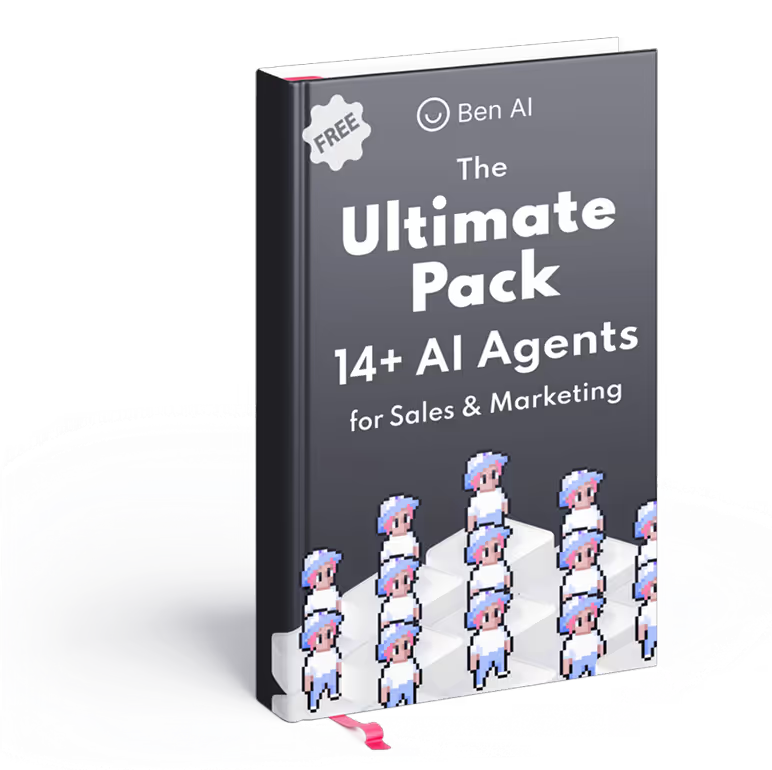
Latest Blogs
Explore our latest blog posts and insights.


